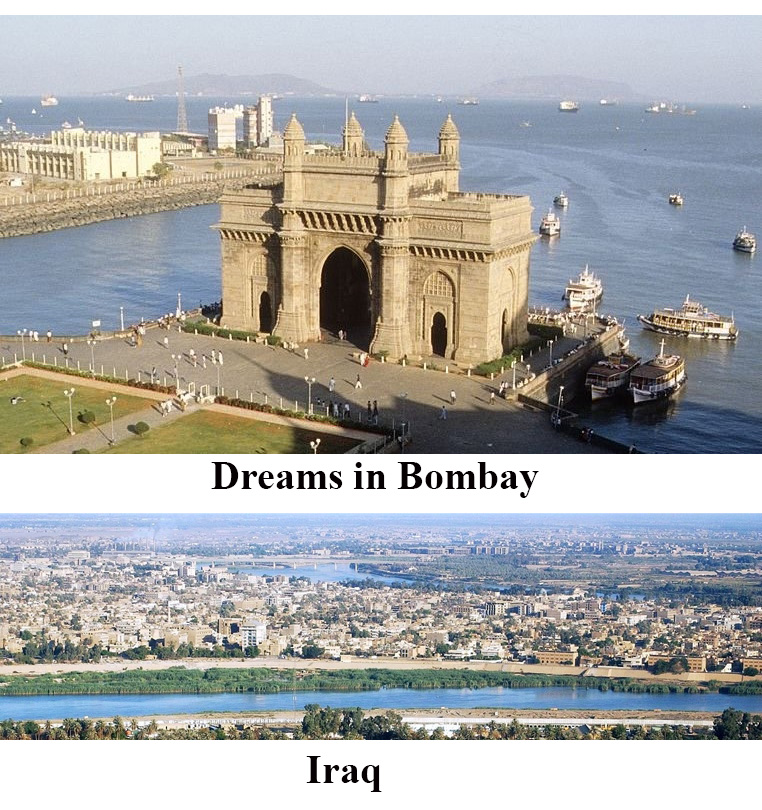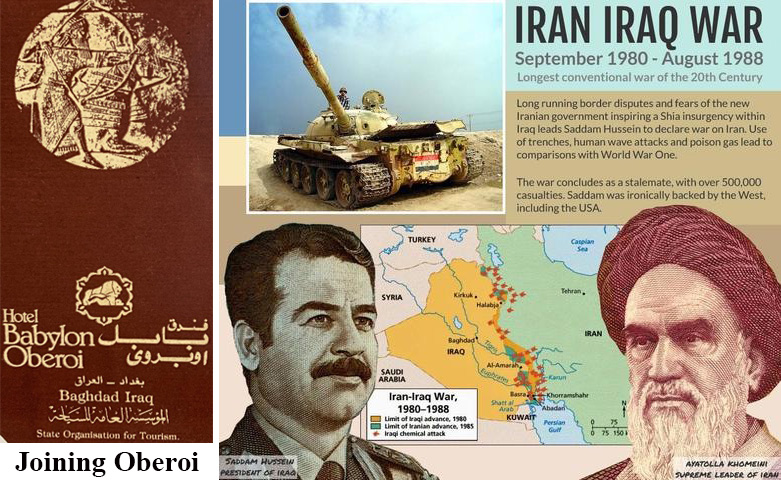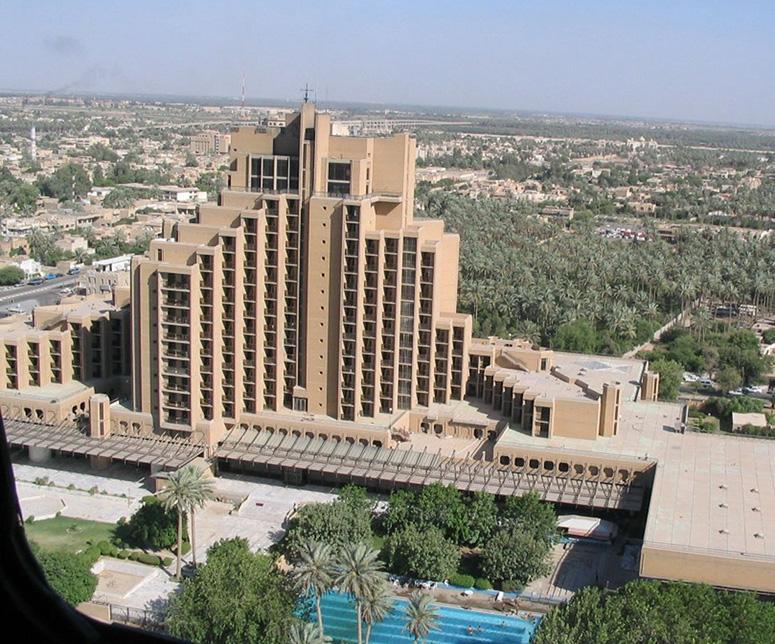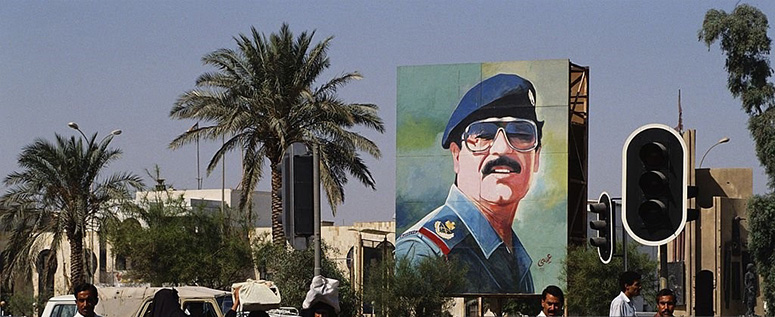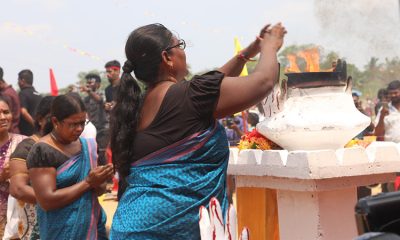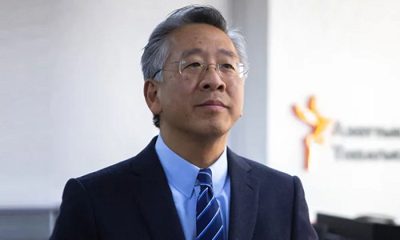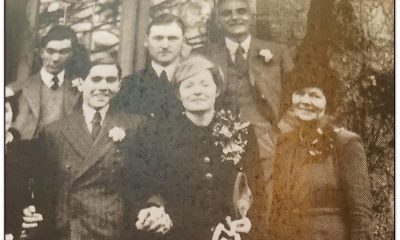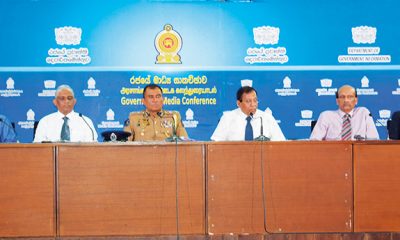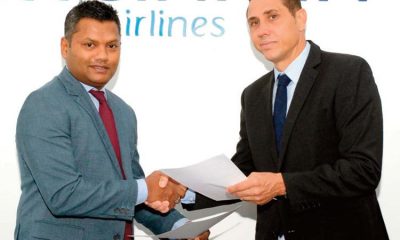Features
From Violent Colombo to Peaceful Baghdad
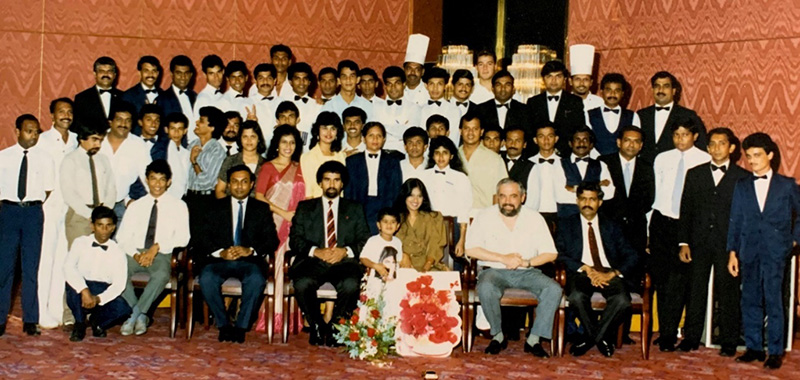
1.PASSIONS OF A GLOBAL HOTELIER
Dr. Chandana (Chandi) Jayawardena DPhil
President – Chandi J. Associates Inc. Consulting, Canada
Founder & Administrator – Global Hospitality Forum
chandij@sympatico.ca
Independent Sri Lanka has faced several disruptions over many decades. Despite short-lived ceasefires and the government’s attempts to encourage extremists to enter peaceful elections, by the late 1980s the government of Sri Lanka was fighting two wars – the LTTE civil war and the second wave of JVP insurgency. Stakeholders of tourism and hospitality industries continued to be resilient. However, by the late 1980s, the situation had deteriorated significantly, casting a shadow of uncertainty over the country’s future. My birth place Colombo had become a violent city with frequent deadly bomb explosions and killings.
In 1989, amidst the turmoil, I found myself at a crossroads in my career journey. As the Director of Food & Beverage at Le Meridien in Colombo, I harboured ambitions beyond the confines of familiarity. Guided by the belief that true growth lies beyond comfort zones, I sought opportunities on the global stage. That was uncommon for a hotelier from a developing country at that time.
Under the mentorship of Jean-Pierre Kaspar, the former General Manager of Le Meridien in Colombo, I envisioned a trajectory that transcended geographical boundaries. With his guidance, I embarked on a path of professional development, honing my skills in diverse settings from Singapore to Paris and London, laying the groundwork for my aspirations.
However, as I shared my ambitions with the new General Manager of Le Galadari Meridien Hotel, Paul Finnegan, I encountered unforeseen obstacles. Despite my eagerness to explore opportunities abroad, the prevailing circumstances constrained my options. Undeterred by setbacks, I resolved to forge ahead in pursuit of my global aspirations, bidding farewell to Le Meridien and Sri Lanka in search of new avenues aligned with my ambitious global career.
Then General Manager of Hotel Lanka Oberoi, Kawal Nain introduced me to Madan Mishra, Vice President for Oberoi in Iraq, and Regional Vice President & General Manager of Hotel Babylon Oberoi in Baghdad. Nain gave me a glowing recommendation. After the formal interview, Mishra invited me to an informal discussion at the London Grill at Hotel Lanka Oberoi, when he hosted my wife and me to dinner.
“As the operator of the three largest and best five-star hotels in Iraq, Oberoi has a key role to play in training hospitality workers and developing tourism in Baghdad and Mosul. Welcome to my top team” said Mr. Mishra as he shook my hand after I signed a two-year expatriate contract with Oberoi.
My boss at Le Meridien was surprised with my quick decision. Paul Finnegan told me, “Chandi, you have decided to leave a global five-star hotel company owned by Air France to join a small regional hotel chain run by an Indian company. That does not make any sense to me, unless you have an exceptionally good reason!” I rested my case by showing him my contract. I told him, “What Oberoi has offered me is five times my current salary at Le Meridien. If you match it and offer me an expatriate contract in another country, I will re-join Le Meridien.” Well, it eventually happened eight years later in 1997, when I opened Le Meridien in Jamaica as its General Manager.
As at that time in Iraq they did not like to use the term ‘Director’, my title would be ‘Food & Beverage Manager’. “You know that over the last 17 years, Oberoi sent two dozens of promising Sri Lankan hoteliers for universally recognized two-year management program at the Oberoi School of Hotel Management in New Delhi. None of them reached the level of Food & Beverage Manager at Hotel Lanka Oberoi.
You would be the first Sri Lankan to hold this very senior position at an Oberoi hotel” Kawal Nain said, and then Madan Mishra explained, “Chandi, you would be our third ranking leader at Babylon Oberoi after me and the Resident Manager. You would be overall in charge of ten food and beverage outlets and banqueting, kitchens, and stewarding. Your team will include 160 employees from 10 countries. Seven of the managers reporting to you would be graduates of the Oberoi School of Hotel Management,” Madan Mishra said.
Mishra then added, “Out of 52 Sri Lankans I have recruited for Babylon Oberoi, you are one of two persons not from Hotel Lanka Oberoi. My friend, Mr. Nain thinks very highly of you, and I respect his judgement.” The other non-Oberoi person in the team was the IT Manager, who was married to Shirani Perera, the Oberoi-trained Executive Housekeeper chosen for Hotel Babylon Oberoi. Prior to our departure to Iraq, I was asked by my new boss to lead the team of 52 from different departments during our travels and until reaching the Hotel Babylon Oberoi in Baghdad.
After the Iran–Iraq War ended in August 1988, with the killing of 500,000 people over a period of eight years, there was optimism about the future of Iraq. It was the longest conventional war of the 20th century, with USA and the West backing Iraq. The year 1989 was important for Iraq, which focused on re-building the country targeting stability, the economy, human capital, and tourism. The country desperately needed external expertise to place those aspirations on a fast track.
In May 1989, I embarked on a journey that would mark a pivotal chapter in my career. Departing from Colombo bound for Bombay (later renamed Mumbai), I found myself among 50 former employees from Hotel Lanka Oberoi. As the sole senior divisional head amidst this group of new recruits for Iraq, I naturally assumed a leadership mantle for the duration of our travels. My prior experience in India, gleaned during a two-week stint seven years earlier as a member of Sri Lanka’s national Judo team. This lent me a deeper familiarity with the country than my companions.
Following a night’s stay, graciously arranged by Oberoi Hotels in Bombay, we proceeded onward with a second flight to Baghdad. Despite the palpable anxiety shared by all 52 of us at the prospect of working in a war-torn region with a vastly diverse culture, we were happy with the high salaries offered to us. It swiftly became apparent to me that acclimatizing myself to three distinct cultures —Iraqi, Indian, and Oberoi— would be paramount. I resolved to make this adaptation my foremost priority and adjust my communication and leadership styles accordingly.
In the lead-up to our arrival in Bombay and during our brief sojourn in that vibrant metropolis, I embarked on a reflective exercise, drafting a concise yet strategic roadmap for my professional career goals. My key ambition was to ascend to the position of General Manager within an internationally renowned hotel chain in the coming years.
In addition, drawing upon my experience as a senior lecturer and my education in ‘Training Methodology’ on an ILO/UNDP Fellowship in Europe, I harboured aspirations of eventually returning to academia to obtain a globally recognized Ph.D. This ambition had already taken tangible form in the submission of a doctoral thesis proposal to the University of Surrey, in England where I had completed my master’s degree in international Hotel Management five years before.
Rounding out my handwritten plan before our descent into Iraq was a vision of eventually establishing an international consultancy firm specializing in hospitality management — an aspiration built upon the satisfaction derived from previous ad hoc consulting engagements.
The lands that now comprise Iraq have a rich historical tapestry, rooted in the ancient region of Mesopotamia, meaning ‘The land between the rivers’. This fertile territory, cradled by the Tigris and Euphrates rivers, nurtured a few of humanity’s earliest civilizations, including the Sumerians, Akkadians, Babylonians, and Assyrians.
Situated within the Fertile Crescent in the Middle East and Mediterranean — an arc of land of 11 modern-day nations spanning from Egypt to Iraq and Iran — this region played a pivotal role in the emergence of settled agricultural communities, dating back to the early ninth millennium BCE. Over millennia, Mesopotamia became a nexus of imperial power, experiencing successive dominions under Persian, Greek, and Roman rulership before becoming an integral part of the Islamic world after the seventh century.
In the aftermath of World War I, the modern nation-state of Iraq emerged from the former Ottoman provinces of Baghdad, Basra, and Mosul, under British colonial administration. Despite formal independence in 1932, Iraq remained under British influence during a disorderly era marked by monarchical rule and subsequent political upheavals.
The influence of the Arab nationalist and socialist Baath Party in 1968 heralded a period of relative stability, fuelled by substantial oil reserves, which enabled ambitious development initiatives and the creation of a formidable armed force. However, this stability in the country was eclipsed by the authoritarian reign of Saddam Hussein, who steered Iraq into disastrous conflicts, including the Iran-Iraq War (1980–1988), the Persian Gulf War (1990–1991), and the Iraq War (2003).
Geopolitically, Iraq is bordered by Iran to the east, Kuwait and Saudi Arabia to the south, Jordan and Syria to the west, and Türkiye, to the north. Despite its strategic location, Iraq possesses only a small coastline along the northern Persian Gulf, offering limited maritime access compared to its regional counterparts.
Iraq’s population has surged, surpassing 47 million — an exponential increase from its 1989 estimate of 17 million, akin to the population of Sri Lanka at that time. Since 1980, amidst three decades marred by conflict, there was a solitary year of peace in 1989 —a year that afforded me the opportunity to experience and engage with the complexities of Iraq first-hand.
Baghdad
Baghdad, a city steeped in vibrant history, was established in 762 AD along the caravan route bridging Asia and Europe. Its strategic position on the banks of the Tigris River propelled it to prominence as a cultural, commercial, and intellectual epicentre of the Islamic world. In 1921, Baghdad became the capital of Iraq.
Despite the tumult of wars and disruptions, Baghdad remained a beacon of learning and commerce, drawing both local inhabitants and international visitors to the country. Its rich tapestry of history finds expression in myriad attractions, from museums and shrines to mosques and bustling souks, contrasted with modern-day amenities such as upscale boutiques and vibrant dining establishments. Upon our arrival at Baghdad International Airport, the prominent presence of large portraits of Saddam Hussein told their own story.
Hotel Babylon Oberoi
Nestled in one of Baghdad’s most coveted neighborhood, adjacent to the verdant expanse of the green zone and overlooking the famed Tigris River, Hotel Babylon Oberoi epitomized five-star luxury. Boasting 300 lavishly decorated rooms and suites, the hotel provided guests with unparalleled convenience and comfort in the heart of down-town Baghdad. Vibrant souks and iconic landmarks were mere minutes away, ensuring an enriching stay for discerning travellers seeking leisure and exploration.
The hotel’s distinctive pyramid architecture and expansive gardens paid homage to Baghdad’s Babylonian legacy, while its culinary offerings stregnthened its status as a premier dining destination. With ten food and beverage outlets, including six dining venues, the hotel provided an enormous gastronomic experience. From the allure of a bustling casino, and a lively nightclub, to the tranquillity of a rooftop bar and a chic lobby lounge, the hotel catered to every indulgence.
For corporate gatherings, weddings, and events, the hotel boasted an elegant ballroom and banquet rooms capable of accommodating up to 600 guests, ensuring a seamless blend of sophistication and functionality. Meanwhile, the outdoor Olympic-size pool, fitness centre, and spa facilities epitomized luxury and wellness, offering guests the pinnacle of relaxation and rejuvenation.
As preparations unfolded for my family’s imminent arrival, I found solace in the warm embrace of Iraqi and Indian management colleagues. With full-board family accommodation secured in a spacious two-bedroom suite overlooking the Tigris River, I embarked on my role as an expatriate manager with a strong sense of purpose.
While my primary focus remained on laying the groundwork for my burgeoning global career, I willingly assumed additional responsibilities at the request of the General Manager. Tasked with overseeing the welfare of 52 Sri Lankan employees, I embraced this role with enthusiasm, cognizant of the importance of fostering a supportive and inclusive work environment. As I settled into my new job, I reflected with satisfaction: “Here I am at age 35, finally as an expatriate manager, living in the luxurious confines of a five-star hotel in a foreign land.”
Features
The heart-friendly health minister

by Dr Gotabhya Ranasinghe
Senior Consultant Cardiologist
National Hospital Sri Lanka
When we sought a meeting with Hon Dr. Ramesh Pathirana, Minister of Health, he graciously cleared his busy schedule to accommodate us. Renowned for his attentive listening and deep understanding, Minister Pathirana is dedicated to advancing the health sector. His openness and transparency exemplify the qualities of an exemplary politician and minister.
Dr. Palitha Mahipala, the current Health Secretary, demonstrates both commendable enthusiasm and unwavering support. This combination of attributes makes him a highly compatible colleague for the esteemed Minister of Health.
Our discussion centered on a project that has been in the works for the past 30 years, one that no other minister had managed to advance.
Minister Pathirana, however, recognized the project’s significance and its potential to revolutionize care for heart patients.
The project involves the construction of a state-of-the-art facility at the premises of the National Hospital Colombo. The project’s location within the premises of the National Hospital underscores its importance and relevance to the healthcare infrastructure of the nation.
This facility will include a cardiology building and a tertiary care center, equipped with the latest technology to handle and treat all types of heart-related conditions and surgeries.
Securing funding was a major milestone for this initiative. Minister Pathirana successfully obtained approval for a $40 billion loan from the Asian Development Bank. With the funding in place, the foundation stone is scheduled to be laid in September this year, and construction will begin in January 2025.
This project guarantees a consistent and uninterrupted supply of stents and related medications for heart patients. As a result, patients will have timely access to essential medical supplies during their treatment and recovery. By securing these critical resources, the project aims to enhance patient outcomes, minimize treatment delays, and maintain the highest standards of cardiac care.
Upon its fruition, this monumental building will serve as a beacon of hope and healing, symbolizing the unwavering dedication to improving patient outcomes and fostering a healthier society.We anticipate a future marked by significant progress and positive outcomes in Sri Lanka’s cardiovascular treatment landscape within the foreseeable timeframe.
Features
A LOVING TRIBUTE TO JESUIT FR. ALOYSIUS PIERIS ON HIS 90th BIRTHDAY

by Fr. Emmanuel Fernando, OMI
Jesuit Fr. Aloysius Pieris (affectionately called Fr. Aloy) celebrated his 90th birthday on April 9, 2024 and I, as the editor of our Oblate Journal, THE MISSIONARY OBLATE had gone to press by that time. Immediately I decided to publish an article, appreciating the untiring selfless services he continues to offer for inter-Faith dialogue, the renewal of the Catholic Church, his concern for the poor and the suffering Sri Lankan masses and to me, the present writer.
It was in 1988, when I was appointed Director of the Oblate Scholastics at Ampitiya by the then Oblate Provincial Fr. Anselm Silva, that I came to know Fr. Aloy more closely. Knowing well his expertise in matters spiritual, theological, Indological and pastoral, and with the collaborative spirit of my companion-formators, our Oblate Scholastics were sent to Tulana, the Research and Encounter Centre, Kelaniya, of which he is the Founder-Director, for ‘exposure-programmes’ on matters spiritual, biblical, theological and pastoral. Some of these dimensions according to my view and that of my companion-formators, were not available at the National Seminary, Ampitiya.
Ever since that time, our Oblate formators/ accompaniers at the Oblate Scholasticate, Ampitiya , have continued to send our Oblate Scholastics to Tulana Centre for deepening their insights and convictions regarding matters needed to serve the people in today’s context. Fr. Aloy also had tried very enthusiastically with the Oblate team headed by Frs. Oswald Firth and Clement Waidyasekara to begin a Theologate, directed by the Religious Congregations in Sri Lanka, for the contextual formation/ accompaniment of their members. It should very well be a desired goal of the Leaders / Provincials of the Religious Congregations.
Besides being a formator/accompanier at the Oblate Scholasticate, I was entrusted also with the task of editing and publishing our Oblate journal, ‘The Missionary Oblate’. To maintain the quality of the journal I continue to depend on Fr. Aloy for his thought-provoking and stimulating articles on Biblical Spirituality, Biblical Theology and Ecclesiology. I am very grateful to him for his generous assistance. Of late, his writings on renewal of the Church, initiated by Pope St. John XX111 and continued by Pope Francis through the Synodal path, published in our Oblate journal, enable our readers to focus their attention also on the needed renewal in the Catholic Church in Sri Lanka. Fr. Aloy appreciated very much the Synodal path adopted by the Jesuit Pope Francis for the renewal of the Church, rooted very much on prayerful discernment. In my Religious and presbyteral life, Fr.Aloy continues to be my spiritual animator / guide and ongoing formator / acccompanier.
Fr. Aloysius Pieris, BA Hons (Lond), LPh (SHC, India), STL (PFT, Naples), PhD (SLU/VC), ThD (Tilburg), D.Ltt (KU), has been one of the eminent Asian theologians well recognized internationally and one who has lectured and held visiting chairs in many universities both in the West and in the East. Many members of Religious Congregations from Asian countries have benefited from his lectures and guidance in the East Asian Pastoral Institute (EAPI) in Manila, Philippines. He had been a Theologian consulted by the Federation of Asian Bishops’ Conferences for many years. During his professorship at the Gregorian University in Rome, he was called to be a member of a special group of advisers on other religions consulted by Pope Paul VI.
Fr. Aloy is the author of more than 30 books and well over 500 Research Papers. Some of his books and articles have been translated and published in several countries. Among those books, one can find the following: 1) The Genesis of an Asian Theology of Liberation (An Autobiographical Excursus on the Art of Theologising in Asia, 2) An Asian Theology of Liberation, 3) Providential Timeliness of Vatican 11 (a long-overdue halt to a scandalous millennium, 4) Give Vatican 11 a chance, 5) Leadership in the Church, 6) Relishing our faith in working for justice (Themes for study and discussion), 7) A Message meant mainly, not exclusively for Jesuits (Background information necessary for helping Francis renew the Church), 8) Lent in Lanka (Reflections and Resolutions, 9) Love meets wisdom (A Christian Experience of Buddhism, 10) Fire and Water 11) God’s Reign for God’s poor, 12) Our Unhiddden Agenda (How we Jesuits work, pray and form our men). He is also the Editor of two journals, Vagdevi, Journal of Religious Reflection and Dialogue, New Series.
Fr. Aloy has a BA in Pali and Sanskrit from the University of London and a Ph.D in Buddhist Philosophy from the University of Sri Lankan, Vidyodaya Campus. On Nov. 23, 2019, he was awarded the prestigious honorary Doctorate of Literature (D.Litt) by the Chancellor of the University of Kelaniya, the Most Venerable Welamitiyawe Dharmakirthi Sri Kusala Dhamma Thera.
Fr. Aloy continues to be a promoter of Gospel values and virtues. Justice as a constitutive dimension of love and social concern for the downtrodden masses are very much noted in his life and work. He had very much appreciated the commitment of the late Fr. Joseph (Joe) Fernando, the National Director of the Social and Economic Centre (SEDEC) for the poor.
In Sri Lanka, a few religious Congregations – the Good Shepherd Sisters, the Christian Brothers, the Marist Brothers and the Oblates – have invited him to animate their members especially during their Provincial Congresses, Chapters and International Conferences. The mainline Christian Churches also have sought his advice and followed his seminars. I, for one, regret very much, that the Sri Lankan authorities of the Catholic Church –today’s Hierarchy—- have not sought Fr.
Aloy’s expertise for the renewal of the Catholic Church in Sri Lanka and thus have not benefited from the immense store of wisdom and insight that he can offer to our local Church while the Sri Lankan bishops who governed the Catholic church in the immediate aftermath of the Second Vatican Council (Edmund Fernando OMI, Anthony de Saram, Leo Nanayakkara OSB, Frank Marcus Fernando, Paul Perera,) visited him and consulted him on many matters. Among the Tamil Bishops, Bishop Rayappu Joseph was keeping close contact with him and Bishop J. Deogupillai hosted him and his team visiting him after the horrible Black July massacre of Tamils.
Features
A fairy tale, success or debacle

Sri Lanka-Singapore Free Trade Agreement
By Gomi Senadhira
senadhiragomi@gmail.com
“You might tell fairy tales, but the progress of a country cannot be achieved through such narratives. A country cannot be developed by making false promises. The country moved backward because of the electoral promises made by political parties throughout time. We have witnessed that the ultimate result of this is the country becoming bankrupt. Unfortunately, many segments of the population have not come to realize this yet.” – President Ranil Wickremesinghe, 2024 Budget speech
Any Sri Lankan would agree with the above words of President Wickremesinghe on the false promises our politicians and officials make and the fairy tales they narrate which bankrupted this country. So, to understand this, let’s look at one such fairy tale with lots of false promises; Ranil Wickremesinghe’s greatest achievement in the area of international trade and investment promotion during the Yahapalana period, Sri Lanka-Singapore Free Trade Agreement (SLSFTA).
It is appropriate and timely to do it now as Finance Minister Wickremesinghe has just presented to parliament a bill on the National Policy on Economic Transformation which includes the establishment of an Office for International Trade and the Sri Lanka Institute of Economics and International Trade.
Was SLSFTA a “Cleverly negotiated Free Trade Agreement” as stated by the (former) Minister of Development Strategies and International Trade Malik Samarawickrama during the Parliamentary Debate on the SLSFTA in July 2018, or a colossal blunder covered up with lies, false promises, and fairy tales? After SLSFTA was signed there were a number of fairy tales published on this agreement by the Ministry of Development Strategies and International, Institute of Policy Studies, and others.
However, for this article, I would like to limit my comments to the speech by Minister Samarawickrama during the Parliamentary Debate, and the two most important areas in the agreement which were covered up with lies, fairy tales, and false promises, namely: revenue loss for Sri Lanka and Investment from Singapore. On the other important area, “Waste products dumping” I do not want to comment here as I have written extensively on the issue.
1. The revenue loss
During the Parliamentary Debate in July 2018, Minister Samarawickrama stated “…. let me reiterate that this FTA with Singapore has been very cleverly negotiated by us…. The liberalisation programme under this FTA has been carefully designed to have the least impact on domestic industry and revenue collection. We have included all revenue sensitive items in the negative list of items which will not be subject to removal of tariff. Therefore, 97.8% revenue from Customs duty is protected. Our tariff liberalisation will take place over a period of 12-15 years! In fact, the revenue earned through tariffs on goods imported from Singapore last year was Rs. 35 billion.
The revenue loss for over the next 15 years due to the FTA is only Rs. 733 million– which when annualised, on average, is just Rs. 51 million. That is just 0.14% per year! So anyone who claims the Singapore FTA causes revenue loss to the Government cannot do basic arithmetic! Mr. Speaker, in conclusion, I call on my fellow members of this House – don’t mislead the public with baseless criticism that is not grounded in facts. Don’t look at petty politics and use these issues for your own political survival.”
I was surprised to read the minister’s speech because an article published in January 2018 in “The Straits Times“, based on information released by the Singaporean Negotiators stated, “…. With the FTA, tariff savings for Singapore exports are estimated to hit $10 million annually“.
As the annual tariff savings (that is the revenue loss for Sri Lanka) calculated by the Singaporean Negotiators, Singaporean $ 10 million (Sri Lankan rupees 1,200 million in 2018) was way above the rupees’ 733 million revenue loss for 15 years estimated by the Sri Lankan negotiators, it was clear to any observer that one of the parties to the agreement had not done the basic arithmetic!
Six years later, according to a report published by “The Morning” newspaper, speaking at the Committee on Public Finance (COPF) on 7th May 2024, Mr Samarawickrama’s chief trade negotiator K.J. Weerasinghehad had admitted “…. that forecasted revenue loss for the Government of Sri Lanka through the Singapore FTA is Rs. 450 million in 2023 and Rs. 1.3 billion in 2024.”
If these numbers are correct, as tariff liberalisation under the SLSFTA has just started, we will pass Rs 2 billion very soon. Then, the question is how Sri Lanka’s trade negotiators made such a colossal blunder. Didn’t they do their basic arithmetic? If they didn’t know how to do basic arithmetic they should have at least done their basic readings. For example, the headline of the article published in The Straits Times in January 2018 was “Singapore, Sri Lanka sign FTA, annual savings of $10m expected”.
Anyway, as Sri Lanka’s chief negotiator reiterated at the COPF meeting that “…. since 99% of the tariffs in Singapore have zero rates of duty, Sri Lanka has agreed on 80% tariff liberalisation over a period of 15 years while expecting Singapore investments to address the imbalance in trade,” let’s turn towards investment.
Investment from Singapore
In July 2018, speaking during the Parliamentary Debate on the FTA this is what Minister Malik Samarawickrama stated on investment from Singapore, “Already, thanks to this FTA, in just the past two-and-a-half months since the agreement came into effect we have received a proposal from Singapore for investment amounting to $ 14.8 billion in an oil refinery for export of petroleum products. In addition, we have proposals for a steel manufacturing plant for exports ($ 1 billion investment), flour milling plant ($ 50 million), sugar refinery ($ 200 million). This adds up to more than $ 16.05 billion in the pipeline on these projects alone.
And all of these projects will create thousands of more jobs for our people. In principle approval has already been granted by the BOI and the investors are awaiting the release of land the environmental approvals to commence the project.
I request the Opposition and those with vested interests to change their narrow-minded thinking and join us to develop our country. We must always look at what is best for the whole community, not just the few who may oppose. We owe it to our people to courageously take decisions that will change their lives for the better.”
According to the media report I quoted earlier, speaking at the Committee on Public Finance (COPF) Chief Negotiator Weerasinghe has admitted that Sri Lanka was not happy with overall Singapore investments that have come in the past few years in return for the trade liberalisation under the Singapore-Sri Lanka Free Trade Agreement. He has added that between 2021 and 2023 the total investment from Singapore had been around $162 million!
What happened to those projects worth $16 billion negotiated, thanks to the SLSFTA, in just the two-and-a-half months after the agreement came into effect and approved by the BOI? I do not know about the steel manufacturing plant for exports ($ 1 billion investment), flour milling plant ($ 50 million) and sugar refinery ($ 200 million).
However, story of the multibillion-dollar investment in the Petroleum Refinery unfolded in a manner that would qualify it as the best fairy tale with false promises presented by our politicians and the officials, prior to 2019 elections.
Though many Sri Lankans got to know, through the media which repeatedly highlighted a plethora of issues surrounding the project and the questionable credentials of the Singaporean investor, the construction work on the Mirrijiwela Oil Refinery along with the cement factory began on the24th of March 2019 with a bang and Minister Ranil Wickremesinghe and his ministers along with the foreign and local dignitaries laid the foundation stones.
That was few months before the 2019 Presidential elections. Inaugurating the construction work Prime Minister Ranil Wickremesinghe said the projects will create thousands of job opportunities in the area and surrounding districts.
The oil refinery, which was to be built over 200 acres of land, with the capacity to refine 200,000 barrels of crude oil per day, was to generate US$7 billion of exports and create 1,500 direct and 3,000 indirect jobs. The construction of the refinery was to be completed in 44 months. Four years later, in August 2023 the Cabinet of Ministers approved the proposal presented by President Ranil Wickremesinghe to cancel the agreement with the investors of the refinery as the project has not been implemented! Can they explain to the country how much money was wasted to produce that fairy tale?
It is obvious that the President, ministers, and officials had made huge blunders and had deliberately misled the public and the parliament on the revenue loss and potential investment from SLSFTA with fairy tales and false promises.
As the president himself said, a country cannot be developed by making false promises or with fairy tales and these false promises and fairy tales had bankrupted the country. “Unfortunately, many segments of the population have not come to realize this yet”.
(The writer, a specialist and an activist on trade and development issues . )

